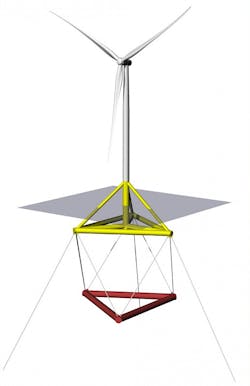Offshore staff
HOUSTON – Floating platform technologies will become increasingly important as global energy markets turn to offshore wind systems to meet demand for renewable energy, said a Stanford University official at the recent Offshore Technology Conference in Houston.
In his presentation on “Floating Offshore Wind: Technology, Policy, and Finance,” Dan Reicher, Senior Adviser at Magellan Wind and Lecturer at Stanford University, noted that “the growth of wind energy has been extraordinary since the early 2000s.”
Like the oil and gas industry, the wind energy industry started onshore, then went into shallow water, then entered deepwater. Thus, the industry is now looking into floating platform designs that will enable offshore wind energy systems to be placed in deepwater.
“The fixed bottom shallow water market is limited,” Reicher observed. This is because most population centers have deep nearshore waters. Because of this, the future of offshore wind energy will be in deepwater, he said. And for this reason, “we need floating wind energy systems.”
“There are prototypes that work, but cost reductions are needed,” Reicher observed. There are a variety of problems with floating wind concepts at present – “they are very heavy, and take a long time to build, requiring massive man hours.”
But there are some “game changers” in the offing, Reicher said, most notably in the form of the TetraSpar floating offshore wind turbine platform concept. This design is being advanced by Henrik Stiesdal, former chief technology officer at Siemens Wind Power and now CEO of Stiesdal Offshore Technologies.
The TetraSpar design includes a tubular steel main structure with a suspended keel that will be moored to the seabed by three anchor lines. With its modular design, the structure could be fabricated quayside, bringing about a leaner manufacturing and assembly process, and lower material costs. The concept is being financially supported by Shell and Innogy, and is expected to be installed at a demonstration site offshore Norway in 200 m of water in 2020.
Offshore wind energy is making significant market gains in Europe and Asia, Reicher said. But the US, he noted, is “catching up.” Only one offshore wind energy system has been built to date off the US coast – the Block Island Wind Farm off Rhode Island. But other states in the New England and northeast regions are also examining the prospect of offshore wind energy.
Wind farms are increasingly being considered off California, “which has the largest single offshore wind resources in the United States,” Reicher observed. The state of California has issued a requirement that 100% of its power generation come from renewable energy by 2045, and this requirement presents a large market opportunity for floating offshore wind technologies, Reicher noted.
But the catch is that the bulk of acreage offshore California is in deepwater. This means that the bulk of wind energy systems contemplated for installation offshore California will have to be placed on floating platform systems.
Reicher noted that the US Department of Interior and the Bureau of Ocean Energy Management have undertaken a number of offshore wind initiatives, and a lease auction for wind energy development offshore California is expected to take place in 2020.
He conceded that “permitting will be a challenge” for any initiative offshore California, given the number of stakeholders involved – the fishing industry, the US Department of Defense, as well as groups and organizations committed to the protection of marine wildlife.
Going forward, Reicher said that “the entire Pacific Rim will be a huge opportunity for offshore wind energy,” including markets not only in California but also in China, Vietnam, Japan, and South Korea.
05/14/2019



